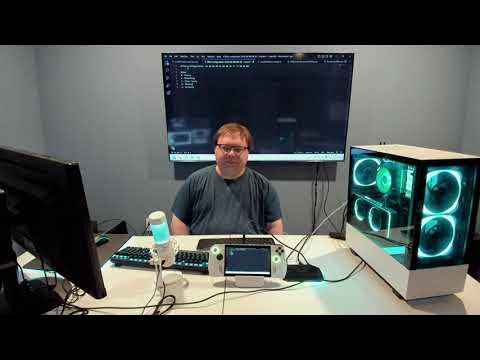I got ab RG35XX Plus when it came out. Very nice little Game Boy style handheld. I played a bunch of GBA, GB, and Genesis games on it but it’s capable of a lot more.
Software Engineer, Linux Enthusiast, OpenRGB Developer, and Gamer
Lemmy.world Profile: https://lemmy.world/u/CalcProgrammer1
- 12 Posts
- 577 Comments
I just got my passport photo taken on Monday at Walgreen’s and uploaded the emailed copy to the online renewal form. It was denied for being too zoomed in. Ugh! Why do they change the photo requirements for the online form?

 4·6 days ago
4·6 days agoI got a NexiGo portable gaming monitor that I’m pretty happy with. It is a 16 inch 2560x1600 display, 144Hz, and supports FreeSync. I got a bidirectional DisplayPort to USB C cable so that I could use it with my desktop for LAN parties and it’s great. It has a built in flip-out kickstand, a folding magnetic cover, OK built in speakers (good enough to game with anyways), and can be powered via a second USB C port with an A to C cable. On a device that supports USB C video output like a laptop or Steam Deck it can run off a single cable but I mostly wanted it for my desktop.

 1·7 days ago
1·7 days agoWhen it first came out it had double steak, when it became a permanent item it was made smaller.

 221·8 days ago
221·8 days agoYou can view WiFi passwords for saved networks on pretty much every OS. There’s no reason to be secretive about entering WiFi passwords, at least to the people whose devices you’re entering the password on.

 91·8 days ago
91·8 days agoLibreWolf on everything that supports it (Windows/Mac/Linux) and Fennec F Droid on Android.

 3·8 days ago
3·8 days agoSome of my favorites:
- Chicken flatbread melt (like a taco but with a fluffy flatbread instead of a tortilla)
- Beefy 5 layer burrito
- Cantina Chicken Quesadilla
- Breakfast Crunchwrap (preferably steak)

 2·8 days ago
2·8 days agoThe Cantina Chicken Quesadilla is one of my favorite items lately. The new green sauce is pretty good too.

 9·1 month ago
9·1 month agoI’ve tried most of the common options (with the notable exception being the vastly overpriced Librem 5). The best option IMO is the OnePlus 6 or 6T (they’re almost identical) running postmarketOS. It is much faster than the PinePhone Pro with way better battery life and has proper modern GPU support (OpenGL up to 4.x, Vulkan). The main thing preventing daily driving the OnePlus 6/6T is that the earpiece audio doesn’t always work for calls and that it won’t wake from sleep when an incoming call comes in. The PinePhones are better to use for voice calling, but slower, lacking many graphics APIs (no Vulkan, limited OpenGL), and have much worse battery life. The camera doesn’t work at all on the OnePlus phones yet, it is starting to work on the PinePhones but the picture quality isn’t all there.
At the moment I have both a OnePlus 6 and 6T, but I have stock Android on the OnePlus 6 and postmarketOS on the 6T. I use the Android one as my daily driver with my primary number SIM but got a second cheap Mint Mobile SIM for the postmarketOS one for experiments and mobile data. I prefer browsing on the postmarketOS phone, and I use it for VPN, SSH access, file management, and some coding on the go which are things Linux phone excels at over Android. I mostly use the Android phone for calls, texts, camera, maps, email (GMail), Discord, and casual browsing. If they fix the earpiece audio issue I would probably be fine daily driving the

 29·1 month ago
29·1 month agoOpen source NVIDIA drivers (NVK, nouveau, nova) finally being usable for gaming.
Linux phones, postmarketOS
RISC-V CPUs becoming more and more viable
Linux on phones and tablets is a thing. Typing from my Xiaomi Pad 5 Pro running postmarketOS and LibreWolf.

 3·1 month ago
3·1 month agoHow is the external display connected? I have never seen Freesync over HDMI work. The early implementations were AMD proprietary and the new ones require HDMI 2.1 which has some ridiculous bullshit about not being implemented by open source drivers. HDMI sucks, use DisplayPort if possible. If your laptop doesn’t have a DisplayPort connector, try a USB-C to DisplayPort cable, as usually the type C ports on laptops support DisplayPort alt mode.

 4·1 month ago
4·1 month agoFreddy’s fry sauce, barbecue sauce, teriyaki sauce, honey mustard, cocktail sauce, malt vinegar, cheese sauce

 1·1 month ago
1·1 month agoAre you testing this on a Raspberry Pi? The PAN_ prefix seems to indicate this is a configuration for the Panfrost driver (which is the open source driver for ARM Mali GPUs) and the Raspberry Pi does not use an ARM Mali but rather a Broadcom VideoCore GPU, so I don’t see how this would affect the Raspberry Pi.
The only instance I can see this is if a game requires a new Vulkan extension, which wouldn’t need a new kernel but would need a new Mesa version to provide that extension. For the most part, games use established and standardized APIs (OpenGL, Vulkan, Direct3D) to utilize the GPU and as long as the driver implements the APIs used by the game, the driver doesn’t need to continuously update in order to support game updates. On Linux, the driver doesn’t handle Direct3D anyways and an intermediate layer (DXVK or VKD3D) is used to translate Direct3D API calls into the Vulkan API. Vulkan does support extensions which are added every so often to provide new interfaces and the userspace portion of the driver (which is responsible for compiling/translating Vulkan API calls into raw GPU instructions) needs to be updated to support these, but also sometimes these extensions are optional and games can use less optimized code paths to work around missing extensions.
I wish these implementations of secure boot were designed more to protect the SOFTWARE against “theft” than the HARDWARE against “tampering”. Let us wipe the secure boot keys, but in the process erase the firmware (or have the firmware encrypted so that erasing the keys renders it unbootable) and then allow new code to run. Blocking third party firmware on consumer devices is a shit move. It just creates more e-waste when the OEM stops updating it and the community can’t make their own replacement firmware.

 3·1 month ago
3·1 month agoPretty much all ext4 except for a few Windows installs on NTFS.
True, but if you buy a finished product that uses the new chip that has secure boot enabled, you can’t flash your own firmware. From what I gather, the boot keys are burned into OTP memory so they can’t be erased or changed. The chip is permanently locked to that firmware.














Concord